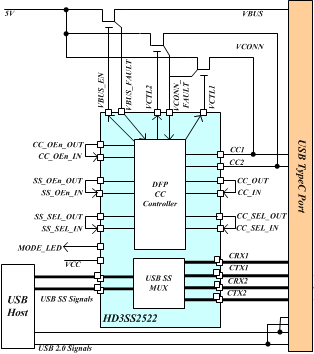ZHCSDQ8 April 2015 HD3SS2522
PRODUCTION DATA.
- 1 特性
- 2 应用
- 3 说明
- 4 简化电路原理图
- 5 修订历史记录
- 6 Pin Configuration and Functions
- 7 Specifications
- 8 Detailed Description
- 9 Application and Implementation
- 10Power Supply Recommendations
- 11Layout
- 12器件和文档支持
- 13机械、封装和可订购信息
8 Detailed Description
8.1 Overview
HD3SS2522 is a 10-Gbps USB mux with Configuration Channel (CC) logic with DFP support. The HD3SS2522 presents itself as a DFP according to the USB Type-C Spec. The CC logic block monitors the CC1 and CC2 pin voltages to determine when a USB port has been attached. Once a USB port has been attached, the CC logic also determines the orientation of the cable and configures the USB SS mux accordingly.
The device provides an VBUS_EN signal to control legacy power switch to provide 5 V to VBUS. The device also provides IOs needed to support 5 V VCONN sourcing for ecosystems implementing USB Type-C.
Excellent dynamic characteristics of the device allow high speed switching with minimum attenuation to the signal eye diagram and little added jitter. The device also has low current consumption in Standby mode.
8.2 Functional Block Diagram

8.3 Feature Description
8.3.1 Adaptive Common Mode Tracking for USB 3.1 MUX
The device provides an integrated USB 3.1 2:1 passive MUX. The MUX provides adaptive common mode tracking allowing RX and TX channels to have different common mode voltage. This feature allows simpler system implementation.
8.3.2 DFP-to-UFP Attach/Detach Detection
The HD3SS2522 monitors the CC lines as a Type-C DFP port. When the device senses that one of the CC has a resistance to GND, it detects that an UFP is attached. The device provides an emulated ID signal (VBUS_EN) in the event of a UFP attach.
The device also monitors specified pull down resistor according to Type-C specifications to determine if an active cable is attached. In the event of active cable detection, HD3SS2522 provides necessary control signals for VCONN switches that provide 5-V VCONN power to appropriate CC pin.
8.3.3 Plug Orientation/Cable Twist Detection
According to USB Type-C specifications plug can be inserted into a receptacle in either one of two orientations. HD3SS2522 monitors for a pull-down resistors from an attached UFP port determining the MUX orientation.
8.3.4 VBUS Fault
HD3SS2522 does not take any action in case of a VBUS fault. VBUS fault needs to be handled by legacy power management implementations.
8.3.5 VCONN Fault
If a VCONN fault is determined by the external power switch and fed into the device through VCONN_FAULT pin, HD3SS2522 will latch it off until the cable is unplugged if there is a fault that does not clear within 5 ms. Which is a sufficient amount of time to charge the 10-µF inrush capacitance.
8.4 Device Functional Modes
8.4.1 Unattached.DFP State
In this state, the HD3SS2522 as a DFP port is waiting to detect the presence of a UFP. The device injects pull-up currents to both of the CC lines.
8.4.2 Attached.DFP State
When HD3SS2522 is in the Attached.DFP state, the port is attached and operating as a DFP. The device continues to monitor the CC pins to make sure the appropriate pin is within vRd range specified by Type-C specification. The device source current on one of the this CC pins and monitor its voltage. The port advertises one of the three levels of VBUS power capability as specified in Type-C spec according to GPIO pins IMODE1 and IMODE2.
The device controls the VCONN power switches to apply VCONN to the unused CC pin if the voltage on the unused CC pin is within the vRa range as specified in Type-C specification.